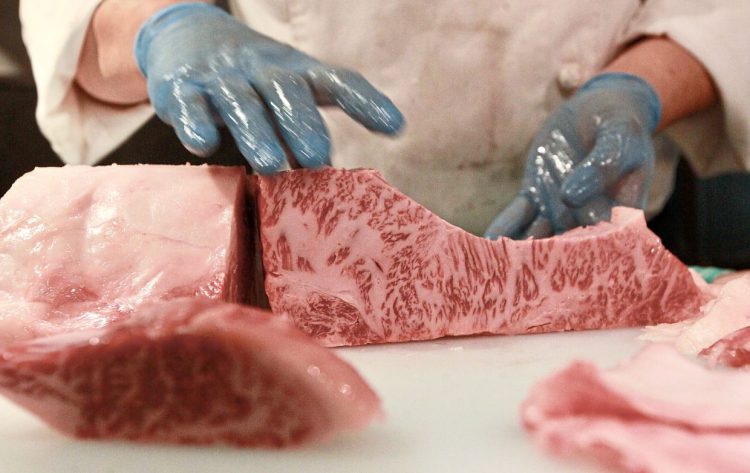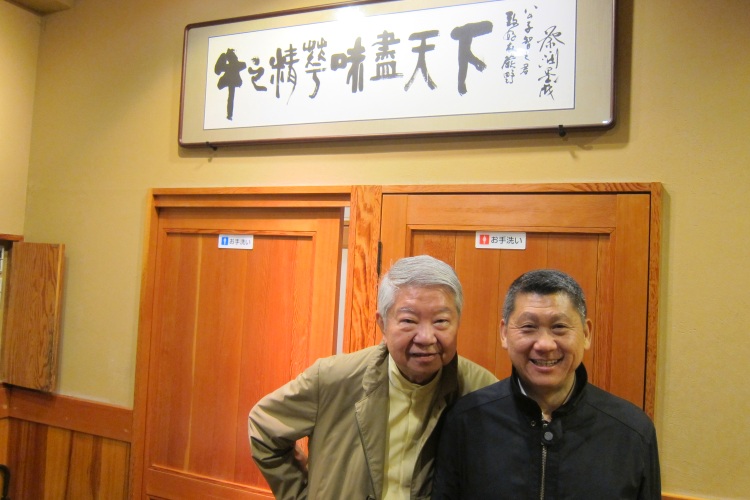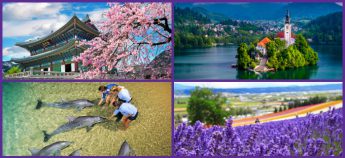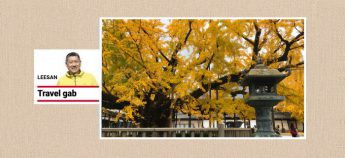Indeed, 2020 has been a total shithole. Soon after we bade the winter snow adieu early this year and before we could even usher in the spring and the subsequent seasons, we were brutally greeted by the snowstorms in Europe, North America, Japan and elsewhere.
Let’s get beefed up – by leesan
Let’s get beefed up for wagyu, the meat that melts in your mouth.
When some clients register for our Japan tours, they would specify that they do not eat beef. However, after arriving in Japan, a few would actually try eating wagyu, which, of course, is a type of beef.

The columnist’s used to take his guests to teppanyaki restaurants in Japan to feast on a wagyu meal. — Photos: LEESAN
Also, milk served at buffet breakfast spreads in Japanese hotels, as well as wagyu skewers at dinner are always snapped up by tourists in no time.
So, what makes wagyu so appealing that these folks would even change their dietary habit?
Perhaps they were curious when the tour guide informed them that wagyu will “instantly melt in their mouth”. After all, a claim like that would always need to be verified!
But let me tell you another reason.
Have you ever seen a 10,000-yen note? An image of Fukuzawa Yukichi is on this note. He founded the famous Keio University in 1858, and is seen as a great thinker, economist and educator in modern-day Japan. Later, towards the end of the Tokugawa Period and during the Meiji Restoration in 1868, Fukuzawa played a pivotal role in the governance of Japan by proposing a British-style Parliament; he also advocated for a Eurocentric policy.
Among his achievements are introducing economics from the English-speaking world to Japan, and the concept of modern insurance. He even boldly introduced Western beef and milk to Emperor Meiji, who was vegetarian!
Like many other Japanese, Fukuzawa was vegetarian too. In fact, the Japanese had been abstaining from meat for about 1,200 years before that. But on one of his three trips to the West, he fell ill, and the Western doctor told him his body was too weak and that he needed to take some meat for protein. Fukuzawa had no choice but to break the precept.
Upon his return to Japan, Fukuzawa told the Emperor that the Westerners were physically stronger because they consume beef and milk.

Wagyu origin Tajiri gou since 1939. And now 99% of wagyu are Tajiri gou.(Photo by internet)

The Japanese Black is one of six native Japanese cattle breeds, and one of four Japanese wagyu. — Wikimedia Commons

The price of wagyu varies, but as a rough guide, check its beef marbling standard or BMS – the higher the standard, the more expensive it gets. — Filepic
So, on Jan 26,1872, after listening to the scientific proposals by Fukuzawa and other politicians, and considering the country’s health and military needs, the Emperor agreed to lift the “meat ban” that had been in place in Japan for so many generations.
Following the royal decree, Japan began to improve on its quality of poultry, and brought in foreign beef and dairy cattle for breeding in Japan. It was said that in the bustling Ginza area near the palace, one whole yellow cow could be sold off each day back then.
Suddenly, there emerged a craze among the Japanese to eat beef and more Westernised meals, particularly French cuisine. Since then, the average height of the Japanese gradually rose from 1.5m to 1.65m; today it is 1.75m.
And if that’s not enough, thanks to beef and milk, the Japanese defeated the Qing Dynasty from China as well as the Russians, and occupied much of Asia-Pacific during World War II.
While leading the nation, Emperor Meiji also encouraged his people to develop the livestock industry to achieve the country’s food security goals.
In 1939, Japanese breeders successfully developed the original wagyu species, Tajiri-go, from the Tajima region. In under 50 years, the Japanese developed four new wagyu species from the Tajima cattle, namely Kuroge wagyu that makes up almost 90% of all wagyu in Japan; the Japanese Brown; the Shorthorn; and the Japanese Polled. Today, Japan boasts a total of 150 wagyu species.
That said, the Japanese remain very particular about wagyu lineage. You can cross breed cattle in any way but must never deviate from the original Tajiri-go.
Anyway, the key to the success of producing high quality beef lies in the attitude and spirit of cattle breeders across Japan they are focused, professional, and have a caring heart. The Japanese craftsmanship is unique in the world in its commitment to honourability and branding.
In addition to the environment and the use of organic feed and vitamin C hay, Japanese cattle farmers also “massage” their cows on a regular basis for firmer and more evenly distributed fat.
A wagyu cow will normally grow up to 800kg in about 30 months. The quality of meat far supersedes that of European, American or Australian beef. It is tender, and the texture is superior, too.
Meanwhile, Japanese milk is also known for its thick and strong aroma. Having travelled across much of the world, I would say that I have never tasted anything as pure and satisfying as Japan’s “Snow Brand” milk.
In order to get to know wagyu better, I would usually arrange for my group members to visit a famous supermarket in Shinjuku, Tokyo. Cattle farms are out of bounds to visitors, so this is the next best thing.
Most of the people in my group would usually be surprised to see that each strip of wagyu is tagged with a “birth certificate”, showing the cow’s lineage, name of breeder, place of birth, marbling score, A2-A5 grading and other details. It’s a small card, but you get to see the cow’s DNA report!

WAGYU JAPANESE BEEF trademark registered in 2017. Since then, The highest grade A5 Wagyu is imported directly from Japan to prevent illicit trafficking of counterfeiting.(Photo from JUSTIA trademarks)
Of course, wagyu’s pricing is… complicated. A wagyu cow is purchased at the highest bidding price at auctions, then the retailer will price individual parts of the body accordingly.
An A5-grade wagyu for teppanyaki is typically priced upwards of RM400 per 100g this means there are more superior and exorbitantly priced wagyu.
In wagyu grading, Grade A wagyu has a meat-to-fat thickness ratio of at least 72%; for Grade B at least 69%; and Grade C below 69%.
Additionally, the marbling and firmness are rated from one to five. Nevertheless, what is often overlooked by an average tourist, but is of tremendous importance to chefs and wagyu connoisseurs, is the distribution of fat, i.e. the beef marbling standard or BMS (from one to 12). Basically, the higher standard, the more expensive the cut… and the faster the meat will melt in one’s mouth!
Someone once said that among the variants of A5 wagyu, Matsusaka is the best in the world, as it “instantly” melts in the mouth. Kobe beef is globally known for its uniformly distributed fat and lean meat, while Omi beef boasts delicate meat texture.
But for me, Sandagyu, Maesawa, Yonezawa, Tajima, Hida, Ishigaki and Tokushima are excellent options, too.
These wagyu variants range from five to eight in BMS grading and are quite reasonably priced.
As for A3 and A4 wagyu, I would suggest that you try the Shiraoi and Tokachi wagyu from Hokkaido for a start. I am sure that you would still get hooked on wagyu after eating these.
Ps: Moo… if I were to be a cow in my next life, I hope to be a wagyu!
The views expressed are entirely the writer’s own. Leesan, the founder of Apple Vacations, has travelled to 132 countries, six continents and enjoys sharing his travel stories and insights. He has also authored two books.

The columnist(right) with Hong Kong gourmet master Chua Lam, at one of their favourite restaurants, Hien, in Kobe, which serves charcoal-grilled Sanda wagyu.
Chua Lam presents his praises in calligraphy to the owner of “Hien”.

Louis Cha aka Zha Liangyong’s (better known by his pen name Jin Yong)calligraphy in the Kobe “Hien” restaurant, with his praise “The beef is super delicious(Cantonese:牛肉靚到飞起) “.

Published in STAR 2, 16 Jan 2021
全球超过80000家酒店,Apple101助您轻松订房,出行无忧,绝对优惠价。入住期间付款,多数客房可免费取消!











